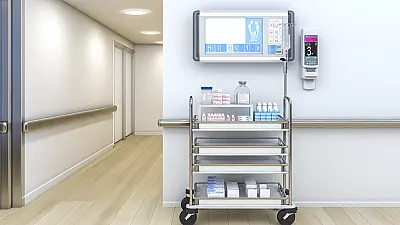HAWTHORNE, NV - Federal inspectors documented serious safety hazards at Lefa Seran SNF during an April 2025 inspection, including a baited rodent trap placed in a resident's bathroom and staff medications left unsecured where residents could access them.

Dangerous Rodent Control Practices Put Residents at Risk
Federal inspectors discovered a wooden spring-loaded rodent trap set and baited with peanut butter in a resident's bathroom, creating a significant injury hazard. The resident reported waking up one night to see a mouse near the bathroom entrance and informing staff about the problem.
The facility's response was to place a trap designed to snap shut with enough force to kill rodents directly in the resident's pathway. This created an immediate risk of foot injury if the resident accidentally triggered the mechanism while entering the bathroom, particularly concerning given that many nursing home residents have mobility issues, vision problems, or cognitive impairments that could make them more likely to accidentally step on such devices.
The Director of Nursing acknowledged that the facility had found no evidence of mice in resident rooms and confirmed the trap could have been a safety hazard if the resident accidentally triggered it. This admission highlights a fundamental failure in the facility's approach to pest control - implementing a dangerous solution without proper assessment of the actual problem.
Professional pest control in healthcare facilities requires specialized approaches that prioritize resident safety. Standard protocols call for using tamper-resistant bait stations, sealed traps placed away from resident areas, or professional-grade exclusion methods that prevent rodent entry without creating hazards for vulnerable populations.
Staff Medications Left Accessible to Residents
Inspectors found an even more serious safety violation when they discovered an open duffle bag containing four prescription medications belonging to a staff member left unattended at the nurses' station. The medications remained unsecured and visible to residents for an unknown period, creating a potentially life-threatening situation.
The unsecured medications included three blood pressure medications: Hydrochlorothiazide 25mg, Lisinopril 10mg, Losartan potassium 100mg, and Losartan potassium 50mg. A registered nurse confirmed these medications "could have caused a resident's blood pressure to bottom out," meaning they could render blood pressure dangerously low enough to create a medical emergency.
This violation represents a critical breakdown in basic safety protocols. Blood pressure medications can cause severe hypotension (dangerously low blood pressure) in individuals not prescribed these drugs, potentially leading to falls, fainting, organ damage, or cardiovascular collapse. Elderly nursing home residents are particularly vulnerable to these effects due to age-related changes in drug metabolism and existing health conditions.
The Director of Nursing confirmed that facility policy required staff to secure personal belongings and prevent resident access to unprescribed medications, yet these safety measures clearly failed. Professional healthcare environments mandate strict medication security protocols, including locked storage for all pharmaceuticals and immediate reporting of any medication security breaches.
Critical Weight Loss Goes Unaddressed
Inspectors identified a concerning failure in nutritional monitoring when they found a resident who had experienced a significant 15% weight loss over three months without proper facility response. The resident's weight dropped from 181.9 pounds in January 2025 to 154.6 pounds by April 2025.
During the inspection, the resident appeared visibly gaunt with a sunken appearance around the eyes and cheeks. The resident reported eating less due to decreased appetite and not liking the facility's food, stating a belief that weight loss had occurred because of not eating.
Despite this dramatic weight loss, the facility failed to follow its own policy requiring residents with significant weight changes to be reweighed the following day and to have the registered dietitian notified. The attending registered nurse stated they would not contact the dietitian about the weight loss, demonstrating a concerning lack of understanding about proper nutritional monitoring protocols.
Rapid weight loss in elderly nursing home residents signals serious underlying issues requiring immediate intervention. A 15% weight loss over three months indicates severe malnutrition risk, which can lead to weakened immune systems, delayed wound healing, increased fall risk, and higher mortality rates. Professional standards require immediate nutritional assessment, dietary modifications, and often medical evaluation to determine underlying causes.
The facility's registered dietitian, when finally informed during the inspection, confirmed they had not been notified of the weight loss and outlined appropriate interventions including nutritional supplements, increased protein intake, enhanced monitoring, and bloodwork evaluation. These responses demonstrate the level of care that should have been provided immediately when the weight loss was first documented.
Inadequate Activity Care Planning
The inspection also revealed deficiencies in person-centered care planning, specifically regarding activities programming. One resident's care plan documented a goal to "go on a nature adventure" but completely lacked interventions or specific plans for achieving this objective.
The Activities Director admitted to being unaware that interventions were missing from care plans and were necessary to provide activities according to resident preferences. This represents a failure in the fundamental requirement that nursing homes develop comprehensive, person-centered care plans with specific, measurable interventions to meet individual resident needs and preferences.
Professional activity programming in nursing homes serves critical functions beyond entertainment, including maintaining cognitive function, social engagement, physical abilities, and overall quality of life. Incomplete care plans leave residents without structured approaches to meet their individual preferences and therapeutic needs.
Additional Issues Identified
The inspection documented other concerning practices including incomplete care plan documentation and failure to follow established facility policies for weight monitoring and interdisciplinary team communications.
These violations collectively demonstrate systemic issues in safety oversight, policy compliance, and resident-centered care at the facility. Each deficiency represents not just a regulatory failure but a potential threat to resident health, safety, and wellbeing that requires immediate corrective action and ongoing monitoring to prevent recurrence.
Full Inspection Report
The details above represent a summary of key findings. View the complete inspection report for Lefa Seran Snf from 2025-04-10 including all violations, facility responses, and corrective action plans.
💬 Join the Discussion
Comments are moderated. Please keep discussions respectful and relevant to nursing home care quality.